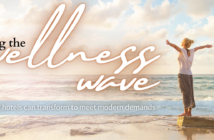Improving the connection between the guest experience and the employee experience.
by LISA SEAY
Imagine: It’s late one night. Let’s actually call it really early in the morning. Ms. Loyalty arrives to check in for the night. Things have obviously not gone as planned for her, as evidenced by an extremely late arrival and the rushed tone, as she gives her name to check-in. John, your new employee, two days removed from training, is at the ready. He’s bright eyed, despite the lateness of the hour and eagerly begins the check-in procedure he has practiced many times.
That’s where things start to go downhill … fast. John can’t find Ms. Loyalty’s reservation. And, he tells her so, creating even more visible stress and huffing and puffing. “Doesn’t he know I have a meeting in four hours and need to get a little sleep?” she thinks. She’s wondering, “Why, of all times, didn’t I do the automatic check-in?” John, meanwhile, is struggling to figure out what to do. The other employee who was supposed to be there with him has called in sick (again!). Obviously, things are not going well for this new employee or for this long-time loyal guest.
Being in the service industry, you are well aware of the connection between the guest experience and the employee experience. You work diligently to ensure both are as positive as possible. Yet, you’re up against some challenges. In the hospitality industry, average turnover rates run as high as 31 percent, according to a Deloitte Hospitality report. Couple that with labor costs of around 33 percent of revenues – the investment in talent is significant. With travelers having more options for their business and personal travel, the pressure to provide an exceptional guest experience is high.
Many things, including the reservation process, cleanliness of the room, availability of amenities such an exercise facility and quality of the restaurant all potentially impact a guest’s experience. But, have you drawn the connection between the guest experience and the employee experience?
In their book The Employee Experience, Tracy Maylett and Matthew Wright explain that focusing on the customer experience to the exclusion of the employee experience is like watering the leaves and ignoring the roots. You probably find it hard to disagree that focusing on employees is important, yet you may be wondering where to begin. There are three key things you can do, particularly when it comes to new employees, that will help set your team members up for success and likely for longer lengths of employment while also supporting a premier guest experience.
EXAMINE YOUR CURRENT ONBOARDING PROGRAM
Onboarding is defined as the action or process of integrating a new employee into an organization. Take a step back and look at the activities associated with a new employee’s integration. Is there a plan for training that incorporates multiple methods of learning? Does your onboarding mostly consist of “on the job” training where new hires sometimes are in the unfortunate position of making mistakes in front of the customer?
Some suggested ways you can assess your current onboarding program include:
- Most simply, you can ask recent new hires what’s working and not. It’s top of mind for them, and they’ll be glad you asked for their feedback. They begin to have a vested interest in providing their feedback and are building commitment to your organization when they know they’ve been heard.
- Talk to your existing employees. Ask them to tell you areas new hires tend to struggle. Perhaps something that is obvious to those doing the actual job is not being incorporated into the new hire training.
- Examine guest feedback. What have they said about where the team seems to be missing the mark? Do any of those areas have themes that involve new employees? Guests may shed light on an issue or concern that may possibly tie back to employees not being trained properly from the beginning.
DESIGN A NEW ONBOARDING PROGRAM
With information in hand from your examination, you can now look at your onboarding program and make any design changes. Some things to consider in your design include:
Make sure your culture is reflected through all of your onboarding process (and you might also want to make sure it’s incorporated in your hiring process too!). Are you teaching your mission and values and instituting multiple check points through the onboarding process to make sure your new hire understands and is embracing that mission and values?
Have you set expectations for the new team member? When an employee is dissatisfied, it typically stems from expectations not being set from the beginning. Does the employee know the uniform requirements and what they’ll have to pay for when it comes to those uniforms? Do they understand that the shift they’re training on may not be the shift they’re assigned when they are done with training? Setting expectations and clarifying them is a crucial part of the design of your onboarding.
SUPPORT YOUR ONBOARDING PROCESS
Once your onboarding process is in place, it’s important to support it with your existing staff and with regular check-ins (and tune-ups) to make sure it’s working in support of your overall strategy. Look at these areas:
- Are buddies and mentors in place for your new hires? Do they have someone that can teach them the job and someone they can become friends with and maybe take a break with at work?
- Is coaching incorporated? Supporting your onboarding with ongoing coaching so that the new hire continues to have a safe place to learn, get feedback and make mistakes is important to fostering an environment of ongoing learning.
- Do you have regular check-ins scheduled with your new hires to find out how things are going? These shouldn’t be “drive-bys” where you say “how are things going?” as you walk quickly past, but should be designed with specific questions to really understand if the things you built into the onboarding program are working.
By examining your onboarding program and being willing to adapt and improve, you are better positioned to compete in the world of staff turnover and competition for guest loyalty – so that both John, the new employee, and Ms. Loyalty, your valued guest, are with you for a long time to come. ■
Lisa Seay is the founder of element c, a consulting firm focused on the employee experience, ranging from the new hire to the exiting veteran. With over 25 years in Human Resources for companies such as Yum Brands and Baylor Scott and White Health Care, she has onboarded thousands of employees and assisted them in creating ongoing career progression and success. She has also designed and implemented onboarding programs to assist organizations in leveraging their most important asset – their people – from day one and beyond.
Photo credit: Peter Mooij/Shutterstock.com




